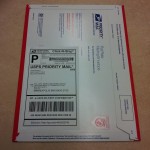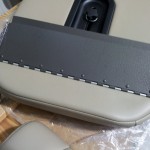Gentlemen, you have an airplane
Out to the airport early today, to meet the DAR for the airworthiness inspection. The inspection went well–shorter than my expectation, a quick engine run, and in the end, I’m the owner of a shiny Special Airworthiness Certificate, now installed in the plane. No squawks on the inspection…hooray!
With that hurdle cleared, the rest of the day was spent reassembling the plane. Inspection covers, fairings, wheelpants, interior panels, carpet were all reinstalled. A few panels remain off, so that the test pilot can re-inspect the flight control systems before the first flight. Because the seat pans are out, the seats are also out, and the cowling is off as well. Before installing the baggage wall, I armed the ELT.
I decided when reinstalling the spinner to see how it would work just using screws, and omitting the tinnerman washers — it turned out nice, the look is much cleaner without the tinnermans, and there is plenty of fiberglass for the heads to bear on, so it shouldn’t be an issue. If required in the future, it’s easy to add them back. For now, I’m alot happier with the way it looks.
I added a #8 nutplate on the underside of the aft tail cone, in front of the tiedown ring, for mounting a video camera. I took one of the GoPro flat surface mounts and modified it so that it could be mounted with a #8 screw and tinnerman washer, as I don’t trust adhesives at 200 mph! Mounted it to the tailcone, and took some test clips to aim the camera. If the mount proves stable enough, the video should be decent — you see the full wingspan at the top of the frame, with a bit of the horizon above, the landing gear, and a wide view of the terrain below. I also snapped in the camera to the mounting point on the roll bar brace, which will get forward-looking video including the panel.
Checked some programming on the VP-X for flap control and wig-wag: making sure the entered airspeeds are correct, fixing the neutral trim position, and locating & setting the 15° flap stop. For now, I’ve left the flaps in momentary (push and hold) mode; after flight testing and proving out the settings, I’ll switch it to position preset mode (where a single click of the switch advances to the next increment of flaps, and a click raises them, without needing to hold the switch).
Re-checked the tire pressures and added air. I intentionally set them a couple PSI higher than the nominal setting; at the rate they deflate, they’ll be right on by tomorrow.
Talked the insurance agent and bound flight coverage effective tomorrow.
Tom Berge is coming down tomorrow, we’ll make an early start and hope to finish up the remaining 3 hours of training, and do the first flight, before the day is up. The weather forecast couldn’t be better: clear skies, cool temps, and little to no wind.
Milestone: 1949.7 logged shop hours, airworthy and ready for first flight!
Hours: 10.0 | Posted in Endgame | Comments Off


































